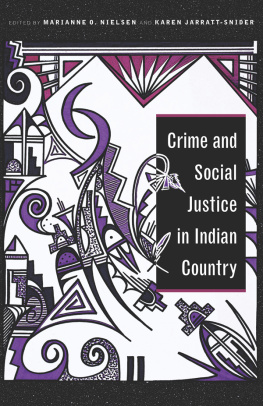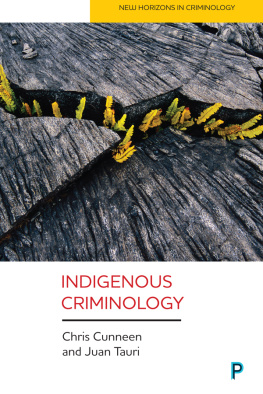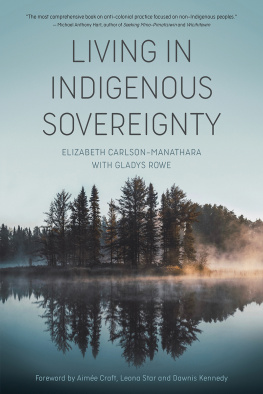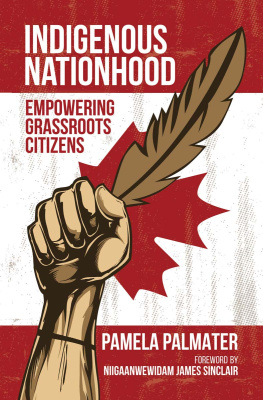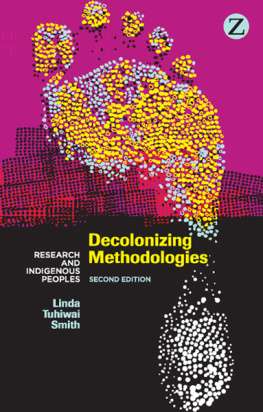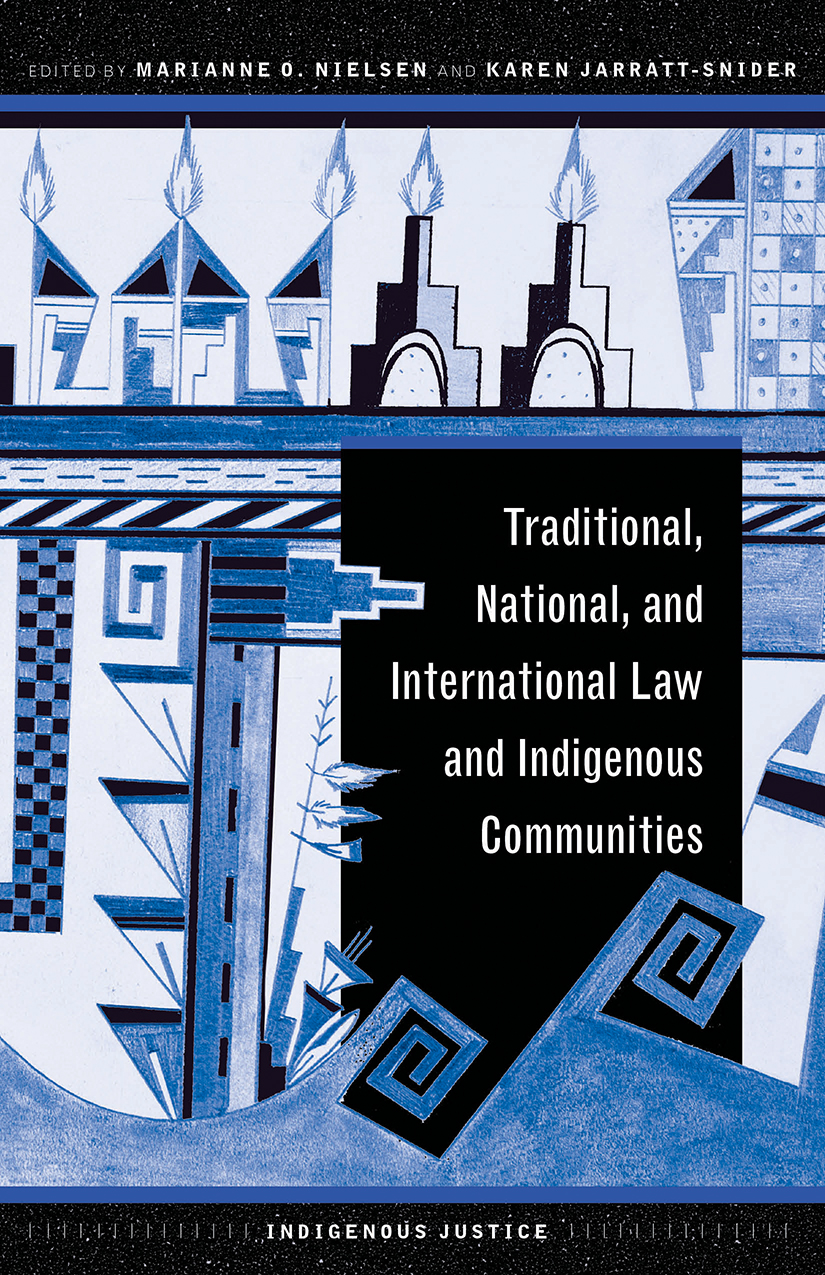
Traditional, National, and International Law and Indigenous Communities
Indigenous Justice
Marianne O. Nielsen and Karen Jarratt-Snider
Series Editors
Traditional, National, and International Law and Indigenous Communities
Edited by Marianne O. Nielsen and Karen Jarratt-Snider

The University of Arizona Press
www.uapress.arizona.edu
2020 by The Arizona Board of Regents
All rights reserved. Published 2020
ISBN-13: 978-0-8165-4041-9 (paper)
Cover design by Leigh McDonald
Cover art by Lomayumtewa K. Ishii
Library of Congress Cataloging-in-Publication Data
Names: Nielsen, Marianne O., editor. | Jarratt-Snider, Karen, editor.
Title: Traditional, national, and international law and indigenous communities / edited by Marianne O. Nielsen and Karen Jarratt-Snider.
Other titles: Indigenous justice.
Description: Tucson : University of Arizona Press, 2020. | Series: Indigenous justice | Includes bibliographical references and index.
Identifiers: LCCN 2019036841 | ISBN 9780816540419 (paperback)
Subjects: LCSH: Indians of North AmericaLegal status, laws, etc. | Indigenous peoplesLegal status, laws, etc.
Classification: LCC KF8205 . T73 2020 | DDC 342.7308/72dc23
LC record available at https://lccn.loc.gov/2019036841
Printed in the United States of America
This paper meets the requirements of ANSI/NISO Z39.48-1992 (Permanence of Paper).
This book is dedicated to our patient partners, Larry Gould and Gary Snider; to Dave, Debbie, and Kristin (from Karen); to Bob and JoAnn (from Marianne); and to the Indigenous scholars who are doing such necessary and innovative research for Indigenous communities.
Contents
Marianne O. Nielsen and Karen Jarratt-Snider
James W. Zion and the Honorable Robert Yazzie
the honorable Raymond D. Austin
Chris Jocks
Kurt D. Siedschlaw
Mary Jo Tippeconnic Fox
Leonardo J. Alvarado
Marianne O. Nielsen
Karen Jarratt-Snider and Marianne O. Nielsen
Acknowledgments
We would like to express our gratitude to the authors and illustrator who contributed to this second book in the series. It took a while to get it into print, and we appreciate your willingness to stick with the project and continue to trust that we would get your work out there. We also thank the peer reviewers for their thought-provoking comments and useful suggestions that helped strengthen this book. To Delsey Benally, thank you for your support and assistance. We want to acknowledge Northern Arizona University for its commitment to Native American students and communities and for encouraging projects such as this. And finally, we want to say thank you to the good people at University of Arizona Press who believed in this project to the point of being willing to publish three (and maybe more) books in the series.
Traditional, National, and International Law and Indigenous Communities
Introduction
Marianne O. Nielsen and Karen Jarratt-Snider
T he relationship between law and ongoing criminal and social justice issues in Indigenous nations and communities is of paramount importance to Indigenous Peoples worldwide. Law has been used as a weapon against Indigenous Peoples since the early days of contact between Indigenous Peoples and the first explorers (Williams 2005). Sometimes this weapon was wielded with intention and sometimes with indifference, as in the case of Lyng v. Northwest Indian Cemetery Protective Association (1988), where it was acknowledged that a logging road that would have severe effects on the ability of Indigenous people to practice their religion was an incidental effect of a government program. Law has also been used to try to ameliorate some of the most tragic consequences of colonialism. In this book respected Indigenous and non-Indigenous scholars in the United States and Canada focus on the responses of Indigenous communities and nations to the impacts of law on Indigenous Peoples, including how Indigenous nations have used law as a strategic tool to attain better lives for their members.
The book focuses on current issues at the confluence of law and Indigenous Peoples, and the resilience, creativity, innovation, and ongoing capacity-building that Indigenous Peoples have shown in response. The context for this confluence is important for understanding the issues and responses described by the books authors. One important context is that Indigenous Peoples have special legal status as the First Peoples of North America and have a body of law that applies only to them. They have made important contributions to their countries legal histories, as can be seen in several chapters in this book.
Another important context is that the United States, like many colonial countries, has multiple legal systems operating at the same time. It practices federalism, with federal, tribal, state, and municipal laws more or less nested together in terms of their jurisdictions (Calavita 2016). The United States also practices legal pluralism where military, British common law-based, French common law-based, and American Indian traditional law-based systems run in parallel. Unfortunately, in the case of Indigenous Peoples this overlap of systems can cause a jurisdictional jungle, as in the case of criminal law (Cardani 2009). This jungle is the result of racism and continual change in federal Indian law and policy as the government tried to fix the Indian Problem throughout previous policy eras. As a result, American Indians living on tribal lands are subject to federal Indian and tribal laws, except in Public Law 280 states where they are subject to federal and state laws. If they live off reservations they are subject to municipal, state, and federal laws like every other citizen. Jurisdiction on Native lands depends on the race of the victim, the race of the offender, and the location of the crime, and too often justice falls between the cracks (see, generally, Getches, Wilkinson, and Williams 1998). Stereotypes and myths about Indigenous people are rampant and influence the decision-making of lawmakers and criminal justice personnel who administer those laws (Nielsen 2009). Federal Indian policy is discussed further in the introduction to part II, National Law.
Adding to this complexity are the special international conventions that protect Indigenous rights such as the United Nations Declaration on the Rights of Indigenous Peoples (2007), but just because a colonial government signs such a declaration does not mean that it incorporates those principles into domestic law, as Indigenous Peoples worldwide are well aware (see Alvarado in this book). Further complicating the matter are the special government bodies, such as the Bureau of Indian Affairs in the United States and Indigenous Services Canada, with their layers of bureaucracy and shifting interpretations of federal law and policy. This legal jungle raises obstacles for communities as they try to achieve opportunity, justice, and fundamental legal and human rights protections, as several authors illustrate.
Another important context is that Indigenous people are a growing population in most colonized countries, many of whom live off Indigenous reservations or reserves. In the United States, for example, about 22 percent live on reservations, with the remainder living elsewhere (U.S. Department of Health 2018). In Canada, about 50 percent of registered Indians live off reserves, as do most of the Aboriginal people who are not registered Indians (Statistics Canada 2015). This means that the special laws in many countries that apply to Indigenous people on Indigenous lands do not affect the majority of Indigenous people, and the legal remedies sought by Indigenous nations do not apply to these individuals and communities (but see Marianne Nielsen in this book). This is a serious hole in the legal landscape that needs further research and future action.
Next page

